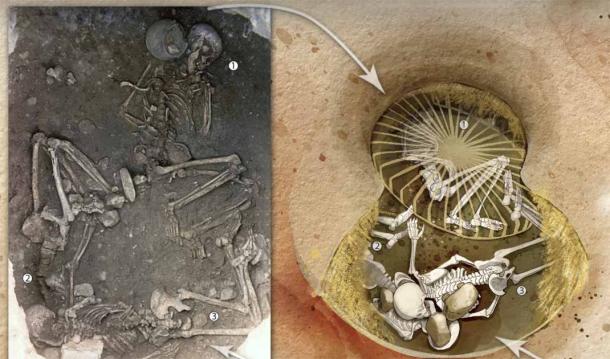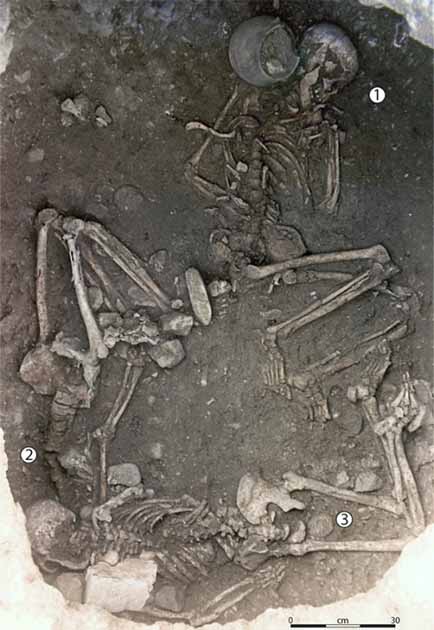
Investigation of Tomb Burial Reveals Sick Neolithic Ritual Sacrifices
Recent research has unearthed chilling evidence of ritual sacrifices in Neolithic Europe, a practice that involved the gruesome method of "incaprettamento" - tying victims' necks to their bent legs, leading to self-strangulation. This study, spearheaded by biological anthropologist Eric Crubézy of Paul Sabatier University and forensic pathologist Bertrand Ludes, has revealed more than a dozen instances of this sacrificial method across Europe, dating from 5400 to 3500 BC. The findings, published in the journal Science Advances, provide a macabre insight into ancient sacrificial practices tied to agricultural rituals.
- Blood for the Gods: 10 Cultures that Engaged in Ritual Sacrifice
- High Levels Of Ancient Extreme Siberian Nomadic Violence Discovered

View taken from the upper part of the storage pit showing the three skeletons, with one individual in a central position (woman 1) and the other two placed under the overhang of the wall (woman 2 and woman 3). The photos were taken with a wide-angle lens; otherwise, all three individuals cannot be captured in a single shot (A. Beeching/Science Advances)
Agricultural Symbolism and Sacrifice
The original discovery at Saint-Paul-Trois-Châteaux near Avignon, France, served as a catalyst for this broader investigation. Initially found over two decades ago, this tomb housed the remains of three women buried around 5500 BC, with two of them now believed to have been victims of sacrificial murder via incaprettamento.

Researchers think that the central skeleton in the grave (marked 1) was an older woman who was buried after dying of natural causes, and that the two other skeletons (marked 2 and 3) were younger sacrificial victims bound "incaprettamento." (Ludes et al./Science Advances)
The site, which mirrored a grain silo and was adorned with agricultural symbols, suggests a ritualistic sacrifice deeply rooted in agricultural practices. The alignment of a wooden structure above the tomb with the solstices and the presence of grain-grinding stones nearby further underscore the ritual's ties to farming and the cycles of nature.
- Glass Delusion: Bizarre Medieval Affliction Left People Shattered
- 6,000-Year-Old Neolithic Burial Mounds were Later Used for Ritual Sacrifice!

Reconstruction of the space at sunrise during the summer solstice with pit 69 intentionally off-centered, possibly to allow the passage of sunlight during the solstice, enabling an officiant to be illuminated. (Ludes et al./Science Advances)
Evidence of a Widespread Practice
This form of human sacrifice appears to have been a widespread and enduring ritual in Neolithic Europe. Crubézy's team, after reviewing archaeological records from across the continent, identified 20 probable cases of incaprettamento at 14 different sites. Additionally, Mesolithic rock art in Sicily's Addaura Cave depicts human figures bound in a similar manner, indicating that the practice might have originated even before the advent of agriculture, as the images there are thought to age from between 12,000-6,000 BC.

Mesolithic rock art scene from the Addaura Cave. (Ludes et al./Science Advances)
Insights from the Tomb
The tomb's investigation offers a poignant narrative. While one of the women seemed to have died a natural death and was buried ceremonially, the other two younger women, their bodies contorted unnaturally due to the bindings that have since decayed, were likely alive when buried. The use of heavy grinding stone fragments to pin them down suggests a struggle for life even in their final moments. This method of sacrifice, ensuring victims were alive at the time of burial, adds a grim layer to our understanding of Neolithic rituals.
The Legacy of Incaprettamento
The study not only illuminates the dark aspects of Neolithic spirituality and its link to agriculture but also traces the continuity of a brutal method of sacrifice through millennia. Remarkably, the practice of incaprettamento, known today as a mark of Mafia brutality, has roots that stretch back to the dawn of agriculture in Europe. The reasons behind its use in the Neolithic era remain speculative, but the possibility that it allowed the community to perceive the victims as participants in their own demise, rather than being overtly murdered, offers a chilling glimpse into the complexities of ancient religious and cultural practices.
Top image: The tomb containing the three skeletons, two of which are thought to be victims of Neolithic ritual sacrifice was built in the style of a silo, or pit for storing grain, within a small wooden structure and surrounded by a trench. Source: Ludes et al/ Science Advances
By Gary Manners
References
Ludes et al., 2024. ‘A ritual murder shaped the Early and Middle Neolithic across Central and Southern Europe’ Sci. Adv. 10, eadl3374 (2024). Available at: https://www.science.org/doi/10.1126/sciadv.adl3374















